The Pacific Northwest Ballet performs during Jacob’s Pillow’s last week of the summer.
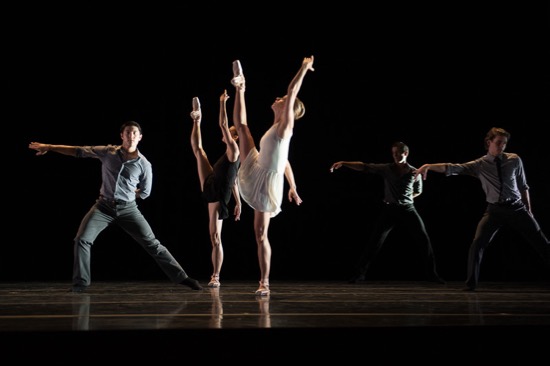
Pacfic Northwest Ballet in Benjamin Millepied’s 3 Movements. (L to R): Christian Poppe, Sarah Ricard Orza, Lesley Rausch, Seth Orza, and Matthew Renko. Photo: Christopher Duggan
It takes more than a moderate climate, ocean breezes, and lots of rain for a ballet company to flourish, and the Seattle’s Pacific Northwest Ballet yields a well-chosen repertory and dancers from all parts of the U.S. and beyond, who make skill and precision look chosen and invested in, rather than elements they learned in a classroom.
Two former members of the New York City Ballet, Francia Russell and Kent Stowell, directed the company from 1977 to 2005; Peter Boal, a notable principal dancer with NYCB, took over from them and has guided the PNB ever since. So you would expect the influence of George Balanchine and Jerome Robbins to color the enterprise’s style and choices of repertory, and to some extent it does—certainly in the program it brought to Jacob’s Pillow during the final week of the Pillow’s 2016 summer season.
Benjamin Millepied was still a principal dancer in NYCB when he choreographed 3 Movements for PNB in 2008. Set to Steve Reich’s 1986 Three Movements for Orchestra, the ballet matches the driving force of the music with an almost constant coming and going of sixteen dancers whose moments on stage overlap, as if pausing were to be avoided at all cost. Now pairs of dancers take over; now it’s the men of the ensemble making an aisle for the women to pass through; now I imagine Millepied setting himself to master counterpoint (can he make legible three small groups doing different things? Yes). On at least one occasion, there’s a temporary snake pit. In terms of driving energy shuttling the spectators among events, experiencing Millepied’s skillfully engineered ballet is in some ways comparable to catching the Olympics on television (that was a killer serve, now back to the diving).
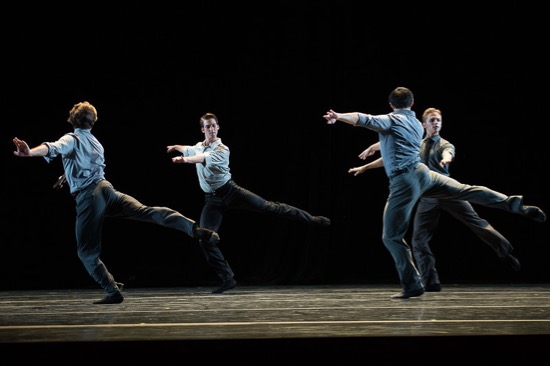
One of the PNB casts in Benjamin Millepied’s 3 Movements. (L to R): Matthew Renko, Miles Pertl, Christian Poppe, and David Wald. Photo: Christopher Duggan
Occasionally the movement reminds me of Robbins’ West Side Story. 3 Movements begins with two men, entering shoulder to shoulder, hunkering down as they skip across the stage; if they were snapping their fingers, you’d think “Jets.” Later four men in one of the two casts (Ryan Cardea, Miles Pertl, Christian Poppe, Dylan Wald) stare, jostle around, and nudge one another, looking for women. Sure enough, four arrive, paying attention mainly to their dancing, and four more trek along the back. And yes, the men do get partners, but there’s no more byplay in Millepied’s ballet; everyone’s here to dance—sometimes in a loose-limbed, free and easy way, sometimes unassumingly classical in style.
In the cast I saw, Jerome Tisserand and Laura Tisserand have fleeting romantic moments, and other dancers swim in and out of prominence: Elizabeth Murphy, William Lin-Yee, Leta Biasucci, and more. Like Reich’s music, Millepied’s ballet is brainy and demanding, an intricate, fast-paced puzzle for intrepid movers. You can imagine that if anyone made a mistake, havoc might result (you know this isn’t true, but that’s the illusion), and you want to cheer for the cast. Its members wear casual, everyday clothes (by Isabella Boylston) in a mostly gray palette. The color is in their dancing.
Kyon Gaines, who attended NYCB’s School of American Ballet, was a member of PNB up to 2015. Now he’s a teacher in the company school and has launched himself into choreography. He made Sum Stravinsky for ten PNB dancers in 2012. I’m not sure what the awkward title implies (“I am Stravinsky?” Surely not), but he has set it to that composer’s Concerto in E-Flat. Known as “Dumbarton Oaks,” it was used by Robbins for NYCB’s momentous 1972 Stravinsky Festival and by Kent Stowell during the 1980s for PNB. Gaines conceived of his ballet as a homage to Balanchine and Stravinsky.
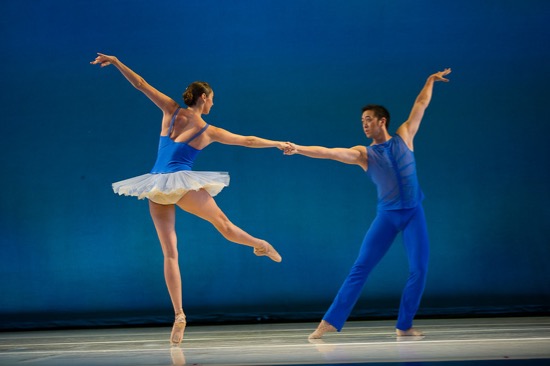
Laura Tisserand and William Lin-Yee in the last movement of Kiyon Gaines’ Sum Stravinsky for Pacific Northwest Ballet. Photo: Christopher Duggan
You can see Balanchine’s influence in some of the details. The playful pertness and flexed wrists of Sarah Ricard Orza in her opening solo and the modern twist on courtliness by her partner, Ezra Thomson. The often-symmetrical stage picture invokes a Russian ballet heritage. Pauline Smith’s attractive update on tutus and Randall G. Chiarelli’s lighting emphasize the deep blue of skies and the lighter blue costumes that brings to mind Balanchine’s Serenade.
In some ways, Stravinsky is like a frisky horse that Gaines is riding. He hits emphatic moments in the music, but often seems a little uneasy about what path to take through the intricate passages. I was grateful when, in the second movement, the music (in defiance of its name, “Allegretto”) turns a bit dreamy and Leah Merchant—slinky in a pussycat way and expansive in the way she uses her upper body—pulls a man (Seth Orza) out of the wings (a clever touch) to be her partner in a calmer, more spacious duet. Jerome Tisserand and Laura Tisserand lead the third movement with its lively cast of three men and three women. J. Tisserand is courtly up to a point, launching his partner into a back flip, but recovering in a pretty pose.
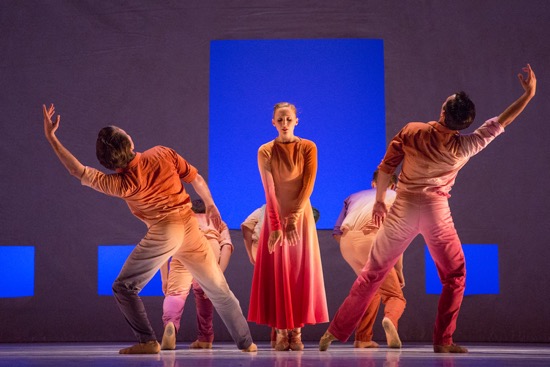
Elizabeth Murphy as the central woman in Jessica Lang’s Her Door to the Sky, flanked by Matthew Renko (L) and Jerome Tisserand. Photo: Hayim Heron
You can admire these dancers more and more as the program unwinds. Jessica Lang’s Her Door to the Sky, a world premiere (co-commissioned by Jacob’s Pillow and PNB) shows them in more potentially dramatic moments. Set to Benjamin Britten’s lovely Simple Symphony, Op. 4 (1933-1934), with its open-air feel, turbulent moments, and melodies you almost feel you know, the piece was inspired by painter Georgia O’Keeffe’s “Patio Door” series, especially those views from the inner courtyard of her house near Taos that show an adobe wall with a single black door that’s set more like a window, plus small rectangles either on the wall beneath it or on the floor in front of it. Lang’s set has a high, square opening in a beige canvas hanging; the little “windows” below it also show the same blue of a desert sky that appears above it (lighting design by Nicole Pearce).
The costumes that Bradon McDonald (once a Mark Morris dancer, now a designer) has dreamed up are remarkable in terms of the movement element they create. It’s as if he wanted to bring the desert wind into the setting. The women’s long-sleeved dresses flow into full skirts; made (I assume) of some light-weight, knitted fabric, they ripple and flare out in the wake of the dancing. These gowns are all sand-colored at the top, but shade into different, irregular swaths of color lower down.
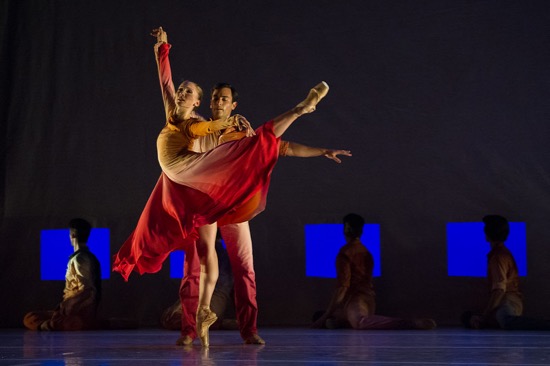
Elizabeth Murphy and Jerome Tisserand in one Jacob’s Pillow cast of Jessica Lang’s Her Door to the Sky. Photo: Christopher Duggan
For the first time in the evening, the dancers often drop to the floor—to rest, to sit and watch, to kneel. At times, faces appear in the small windows—the women outside looking in, or the men sitting inside and looking out. It’s nice when occasionally two women join in one opening, as if wanting to share what they see. The large “door” is set quite high, and it has a wide sill on which a performer may sit or stand.
There are ten dancers in Her Door to the Sky—all of them in the first section and the last one. Part II in the performance I saw was performed by the women of the cast: Biasucci, Elle Macy, Margaret Mullin, Ricard Orza, and L. Tisserand. In Part III, Ricard Orza is surrounded and supported by James Moore, plus Pertl, Matthew Renko, J. Tisserand, and Wald.
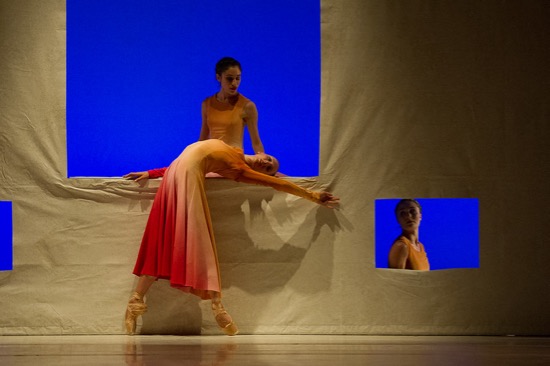
Her Door to the Sky: Elizabeth Murphy (leaning back), Leta Biasucci (on sill), Cecilia Iliescu (looking through window). Photo: Christopher Duggan
The piece has the feeling of a dream, a story not quite told. Four people move slowly in their own way at the back of the stage, while two couples dance more strenuously. The lights dim and brighten again. You sense a community, but an enigmatic one.
If it is a dream, perhaps Ricard Orza is the dreamer. Although Moore is her partner, the other men collaborate to lift her, as if she’s loath to touch the ground. She’s not, though. Slowly extending a leg into the air or bourréeing along on pointe, she seems meditative but not needy. Maybe it was when she arched almost sensuously back over the window sill that I began to wonder if she might represent O’Keeffe—the artist borne along by her visions, shaping herself to her environment. It’s curious, too, the way the men on occasion lie beneath the window, as if sleeping until they’re needed to lift her again.
In the last section, couples dance in jubilation. But at the very end, she raises her arms ecstatically, and, as if she were a conductor leading an orchestra, the others fall, leaving her standing in the window, triumphant.
I’d like to see this splendid company perform Lang’s fascinating, curiously veiled dance again. Not to see beneath those veils, but to comprehend their nature.

Very vivid review–with photos commensurate with your evocative writing.
It sounds as if the end of the Jessica Lang ballet is a sly reversal of the end of Paul Taylor’s “Piazzolla Caldera.” Did it feel that way, as a direct address?
Also, PNB has had strong Balanchine links from the beginning. Its first ballet mistress and school director was Janet Reed, who was succeeded (albeit briefly) by artistic director Melissa Hayden.
An interesting question. No, the ending of Lang’s work didn’t bring Piazzola Caldera to mind, although I see what you mean: Taylor’s principal woman collapses at the end of the dance. In any case. perhaps “triumph” was the wrong word to use, since the central woman wasn’t expressing that kind of feeling over other people, but something more akin to confidence in herself.
Well now, Ms. Jowitt, you make me want to hop on the train and make the 200 mile journey from Portland to Seattle to see Jessica Lang’s “Her Door to the Sky” the next time PNB performs it, and also make me ashamed that many of the dancers I no longer know (although we still miss Leta Biasucci here; she danced for several years with Oregon Ballet Theatre).
As for PNB’s history, I would like to add that Janet Reed, with some help from Todd Bolender, founded PNB’s School, laying the foundation for the company it is today. And Reed shared roots with Kent Stowell: both received their early training from Willam Christensen, the former in Portland and San Francisco, the latter in Salt Lake City. There are many branches to the American ballet tree, which I like to think is the reason it flourishes today.